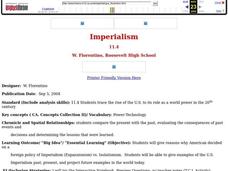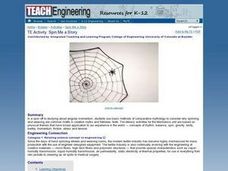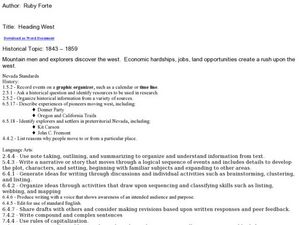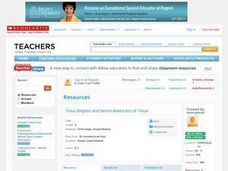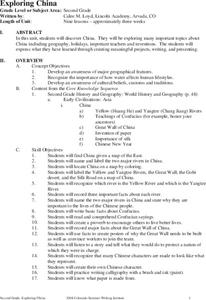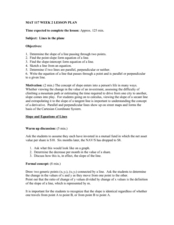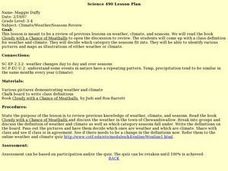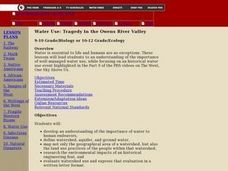Curated OER
Time for Technology Glyphs
Students create a time for technology glyph using Kidpix4. They complete a circle map on things they like to do on while on the computer and write about their favorite thing to do while on a computer.
Curated OER
Weather Forecasting
Fourth graders explore the concepts of weather forecasting. Students locate the current weather in a specified city. In groups, they record the specified weather information and make predictions of weather. Students justify their...
Curated OER
Aboriginal Peoples And The Universals of Culture
Sixth graders research specific features of a province or territory of Canada. In this Canadian history lesson, 6th graders identify aboriginal culture areas on a map, identify cultural features represented in their region, and create...
Curated OER
Imperialism
Students explore the concept of Imperialism. In this foreign policy lesson, students examine the policies of the US and other countries through time. Students then create a political cartoon of their own and create a timeline that...
Curated OER
Teaching The Personality Profile
Young scholars write a comprehensive personality profile feature that demonstrates knowledge of the Wall Street Journal formula of feature writing and the concept of show, don't tell. They experience a press conference interview situation.
Curated OER
Generations: An Exploration of our Families Through Literature
Young scholars complete a unit of lessons on families. They read and analyze various stories, label a map, assemble sentences, write letters to grandparents, analyze character traits, and write and illustrate a sheet for a class book.
Curated OER
Spin Me a Story
Students examine the motif of spinning and weaving in myths and folktales. They read various myths, complete a WebQuest, develop a mind map of story elements, and write an original "spider" story.
Curated OER
If I Had Been at Ellis Island
Students examine what it was like to enter the U.S. as an immigrant. They conduct Internet research, develop a concept map, list the ways children occupied their time while at Ellis Island, and create a diorama.
Curated OER
A Class Census
Students recognize that data represents specific pieces of information about real-world activities, such as the census. In this census instructional activity, students take a class and school-wide census and construct tally charts and...
Curated OER
Heading West
Young scholars study the concept of the westward expansion. For this exploration of the western U.S. lesson, students participate in different activities that explain economic hardships, jobs, and land opportunities. Young scholars...
Curated OER
Aquifers and Groundwater
Young scholars understand the purpose of an aquifer. In this aquifer and groundwater lesson plan, students build a model aquifer find its relationship to water usage. Young scholars record observations as they build the layers of the...
Curated OER
Texas Regions and Native Americans of Texas
Fourth graders research to find the regions of Texas. In this technology instructional activity, 4th graders create a Kid Pix project showing the location of various regions of Texas. Students show where in those regions Native...
Curated OER
Needs and Wants
First graders recognize the difference between needs and wants. In this treaty instructional activity, 1st graders chart their needs and wants to be used in making a treaty. Students negotiate what should be in the treaty based on the...
Curated OER
Arizona
Students engage in a series of lessons about Arizona. They perform experiments and participate in activities across the curriculum. They perform research on websites imbedded in this plan to complete a variety of tasks.
Curated OER
High-Risk Areas
Students create concept maps exploring causes of drug abuse that, in Siberia and around the world, often lead to the contraction of H.I.V., and develop solutions papers.
Curated OER
Exploring China
Second graders explore the geography, holidays, important teachers, and inventions from China in the nine lessons of this unit. The results of their inquiries are expressed through a variety of products, writings, and presentations.
Curated OER
Confucius Say... China Old
Students locate China on the map. In this Chinese geography, history and culture lesson, students read literature about China. Students participate in paper making, silk making and lantern making activities.
Curated OER
Lines in the Plane
Students differentiate between parallel and perpendicular lines. In this algebra lesson, students graph linear equations using the slope intercept form. They classify lines based on their slopes.
Curated OER
Climate Weather Seasons Review
Students review the concepts of weather, climate, and seasons. They read and discuss a book about weather. Students collaborate on a class definition for climate and weather. They match weather to the specific season. Students...
Curated OER
Water Use: Tragedy in the Owens River Valley
Students examine water management issues. In this environmental issues lesson, students watch a PBS video to develop an understanding of watershed, aquifers, and ground water. Students evaluate watershed issues in the Owens River Valley...
Curated OER
Taking the Mystery Out of Mesopotamia
Students locate Mesopotamia on the map and explain the importance of its location. In this Mesopotamia lesson, students understand why the new discoveries of Mesopotamia were so important to civilization. Students participate in...
Curated OER
Ingredients of a Mystery
Students explore the concept of mysteries. For this mystery genre lesson, students identify the common characteristics of mystery books and use a story map to identify these characteristics in a given book. Students also discover the...
Curated OER
Hurricane Frequency and Intensity
Students examine hurricanes. In this web-based meteorology lesson, students study the relationship between ocean temperature and hurricane intensity. They differentiate between intensity and frequency of hurricanes.
Curated OER
Yo-ho, Yo-ho a Viking's Life for Me
Students complete a unit of lessons on the Vikings. They analyze maps, read and discuss myths, summarize the main ideas from resource materials, watch videos, sing a song, draw a picture to illustrate Norse mythology, and define key...





